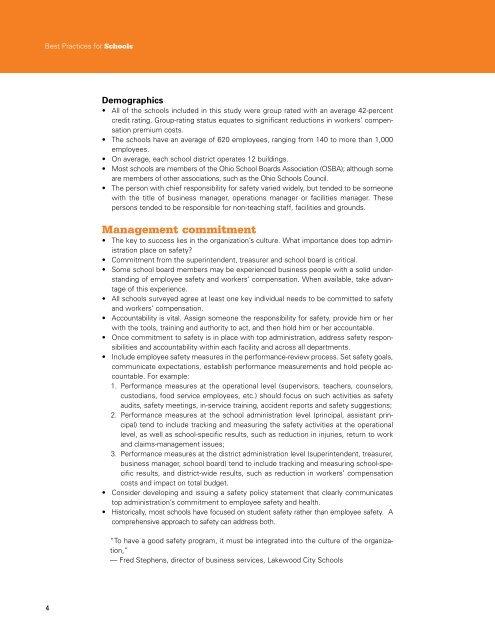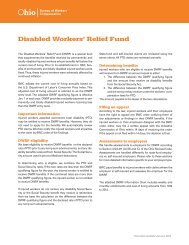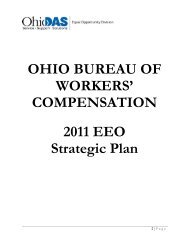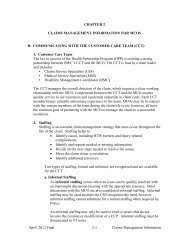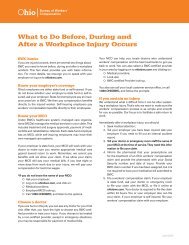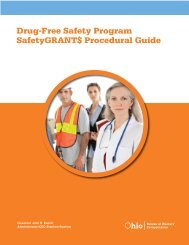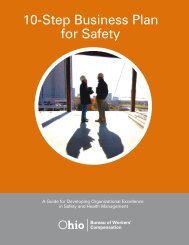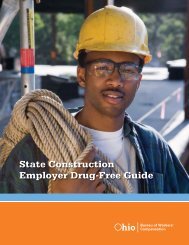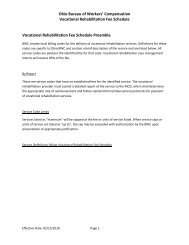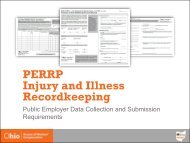Best Practices for Schools - Ohio Bureau of Workers' Compensation
Best Practices for Schools - Ohio Bureau of Workers' Compensation
Best Practices for Schools - Ohio Bureau of Workers' Compensation
Create successful ePaper yourself
Turn your PDF publications into a flip-book with our unique Google optimized e-Paper software.
<strong>Best</strong> <strong>Practices</strong> <strong>for</strong> <strong>Schools</strong><br />
Demographics<br />
• All <strong>of</strong> the schools included in this study were group rated with an average 42-percent<br />
credit rating. Group-rating status equates to significant reductions in workers’ compensation<br />
premium costs.<br />
• The schools have an average <strong>of</strong> 620 employees, ranging from 140 to more than 1,000<br />
employees.<br />
• On average, each school district operates 12 buildings.<br />
• Most schools are members <strong>of</strong> the <strong>Ohio</strong> School Boards Association (OSBA); although some<br />
are members <strong>of</strong> other associations, such as the <strong>Ohio</strong> <strong>Schools</strong> Council.<br />
• The person with chief responsibility <strong>for</strong> safety varied widely, but tended to be someone<br />
with the title <strong>of</strong> business manager, operations manager or facilities manager. These<br />
persons tended to be responsible <strong>for</strong> non-teaching staff, facilities and grounds.<br />
Management commitment<br />
• The key to success lies in the organization’s culture. What importance does top administration<br />
place on safety?<br />
• Commitment from the superintendent, treasurer and school board is critical.<br />
• Some school board members may be experienced business people with a solid understanding<br />
<strong>of</strong> employee safety and workers’ compensation. When available, take advantage<br />
<strong>of</strong> this experience.<br />
• All schools surveyed agree at least one key individual needs to be committed to safety<br />
and workers’ compensation.<br />
• Accountability is vital. Assign someone the responsibility <strong>for</strong> safety, provide him or her<br />
with the tools, training and authority to act, and then hold him or her accountable.<br />
• Once commitment to safety is in place with top administration, address safety responsibilities<br />
and accountability within each facility and across all departments.<br />
• Include employee safety measures in the per<strong>for</strong>mance-review process. Set safety goals,<br />
communicate expectations, establish per<strong>for</strong>mance measurements and hold people accountable.<br />
For example:<br />
1. Per<strong>for</strong>mance measures at the operational level (supervisors, teachers, counselors,<br />
custodians, food service employees, etc.) should focus on such activities as safety<br />
audits, safety meetings, in-service training, accident reports and safety suggestions;<br />
2. Per<strong>for</strong>mance measures at the school administration level (principal, assistant principal)<br />
tend to include tracking and measuring the safety activities at the operational<br />
level, as well as school-specific results, such as reduction in injuries, return to work<br />
and claims-management issues;<br />
3. Per<strong>for</strong>mance measures at the district administration level (superintendent, treasurer,<br />
business manager, school board) tend to include tracking and measuring school-specific<br />
results, and district-wide results, such as reduction in workers’ compensation<br />
costs and impact on total budget.<br />
• Consider developing and issuing a safety policy statement that clearly communicates<br />
top administration’s commitment to employee safety and health.<br />
• Historically, most schools have focused on student safety rather than employee safety. A<br />
comprehensive approach to safety can address both.<br />
“To have a good safety program, it must be integrated into the culture <strong>of</strong> the organization,”<br />
— Fred Stephens, director <strong>of</strong> business services, Lakewood City <strong>Schools</strong>


